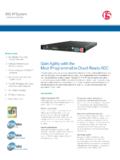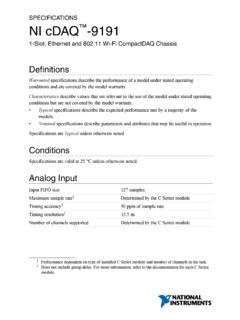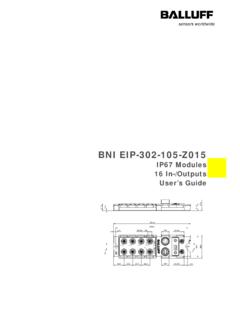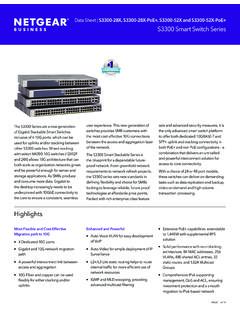Transcription of SAS, NNAS, SSAN - IMEX Research
1 IMEXRESEARCH COM SSSAAASSS,,, NNNAAASSS,,, SSSAAANNN PPPaaasssttt,,, ppprrreeessseeennnttt,,, aaannnddd IMEX SAS vs. NAS vs. SAN - 2 - 2000 IMEX 1997-2000 IMEX Research . All rights reserved. No part of this document may be reproduced in any form, electronic or mechanical, without the expressed written permission of IMEX. SAS vs. NAS vs. SAN - 2 - 2000 IMEX S ince the advent of main-frames, computer scientists have co nsta nt ly wrest le d with vario us architectures to speed the I/O performance with increasing processor performance.
2 Earlier efforts to improve data ac-cess involved tight coupling file sys-tems and I/O with its operating sys-tems. The rise of networked distrib-uted computing brought the chal-lenge of sharing files amongst het-erogeneo us computers running dif-ferent operating systems. This gave rise to network-attached-storage servers to be independent of appli-cations servers and dedicated to only serving files to users while off-loading data management tasks from the over burdened application servers. Faced with the lack of a practical technology that would interconnect theses server, the industry gave birth to a high speed fibre-channel techno logy which in turn provided the impetus for a third generation storage architecture called SAN (or Storage Area Networks) to emerge.
3 SANs create a dedicated network, focused on creating a universal any to any connectivity between storage and server nodes - a network that com-bines the best of mainframe bus and channel's high speed and data in-tegrity benefits with networks' dis-tance benefits, a network that frees the main LAN network from backup duties that consume valuable band-width, a network that is scalable al-lowing increments in capacity with-out disruptions while leveraging the existing investments in legacy plat-forms and existing data, a network that provides centralized control while providing remote data vaulting for disaster recovery, a network that offloads storage management tasks from application servers and speeds up the entire network, thus allowing users the benefit of fast data ac-cess.
4 SANs will eventually be at the core of every enterprise's data cen-ter, allowing companies to design centrally-managed data centers that embrace and interco nnect farflung global SANs and provide service to all of their servers, no matter how far or no matter what operating systems they are running on. This new focus on data stor-age, as a key asset to manage, is obvious given the rise in dollars be-ing spent on storage to the tune of 40-50% of total IT dollars in 1998. The rise in storage requirements, is being fueled by the birth of inces-santly newer internet, data ware-housing and ERP applications and further stoked by the lure of cheap disk drives at 5 cents per MB at the end-user level today.
5 SAS, NAS, SAN Past, present and future. INSIDE: Server Attached Storage Network Attached Storage Storage Area Network Performance SAS vs. NAS vs. SAN its origin, present adoption and future incarnations Outlook for Storage Subsystems, SAS, NAS and SAN Availability the next frontier for Computing Systems on High Availability IMEX Research 1474 Camino Robles San Jose, California 95120 Phone: (408) 268-0800 - Fax: (408) 268-2300 Email: Web: By Anil Vasudev a President, IMEX Research Reprinted from SMS Magazine IMEX Research COM SANs will eventually be at the core of every enterprise s datacenter IMEX Research1474 Camino Robles Jose, CA 95120 Phone: (408) 268-0800 Fax: (408) SAS vs.
6 NAS vs. SAN - 2 - 2000 IMEX SAS Server Attached Storage Early mainframe storage designs took the premise that disk storage, which was cheaper than main memory, could be treated as a extended virtual memory to swap memory-pages. To achieve the fast data access, the data paths (or channels) between storage and processor were widened, the storage bus kept adjacent to the processor bus for data/sig nal integrity while boosting the channel speeds. Server attached storage architectures dominated the scene for several years from mainframe processor channels to PC Server bus slota and adapters. One of the handicaps of the traditional server attached storage comes from the tight coupling between storage and the operating system.
7 A general purpose SAS server performed a variety of tasks concurrently from running applications, manipulating databases, file/print serving, providing communications, checking data-integrity to many housekeeping functions. This meant that all data access requests from a client must continuously compete with these tasks continuously. As the number of users accessing the common centralized data storage increases, the file access takes a back seat to other tasks leading to slow response time for queries. For years one of the major jobs of MIS administrators was to keep the storage performance fine tuned to achieve a certain minimum level of user query response time.
8 Another limitation imposed by the SAS architecture was that of limited distance imposed by the interface - the OEMI wide parallel connections in mainframes and wide differential parallel SCSI connections in servers were limiting the distance between computers and servers to a few meters. This led to the creation of raised-floor data centers but posed a severe constraint and limitation on interconnectivity in multi-site operations. One of the major benefits of fibre channel connectivity that is not fully emphasized, is the removal of spaghetti of OEMI/SCSI wires interconnecting storage to servers and the associated improvement In reliability.
9 This is over and above the advantage of allowing high-speed connectivity and increased distance between centrally managed data repositories and dispersed LAN servers. NAS Network Attached Storage Network Attached Storage, compared to server attached storage on the other hand is a dedicated file server optimized to do just one function only and do it well - file serving. NAS is a system independent, shareable storage that is connected directly to the network and is accessible directly by any number of heterogeneous clients or other servers. NAS file servers are essentially stripped down servers specifically designed for file serving and offloading file management services from the more expensive application servers.
10 In NAS, you can add storage at random without disrupting the network. When the storage was on the server as in SAS, the administrator had to take down the system, install or upgrade the drives and bring the system back up again. That created a lot of unacceptable downtime. NAS is being installed increasingly now to mitigate the downtime associated with SAS. NAS is making inroads into the marketplace at different price, performance and size levels. As business operations become more global and around the clock, more and more General Purpose ServerSAS StorageLANSAS - Server Attached StorageNT ClientNT ClientGeneral Purpose ServerGeneral Purpose ServerSAS StorageLANSAS - Server Attached StorageNT ClientNT Client applications become mission critical demanding 24x7 uptime.






